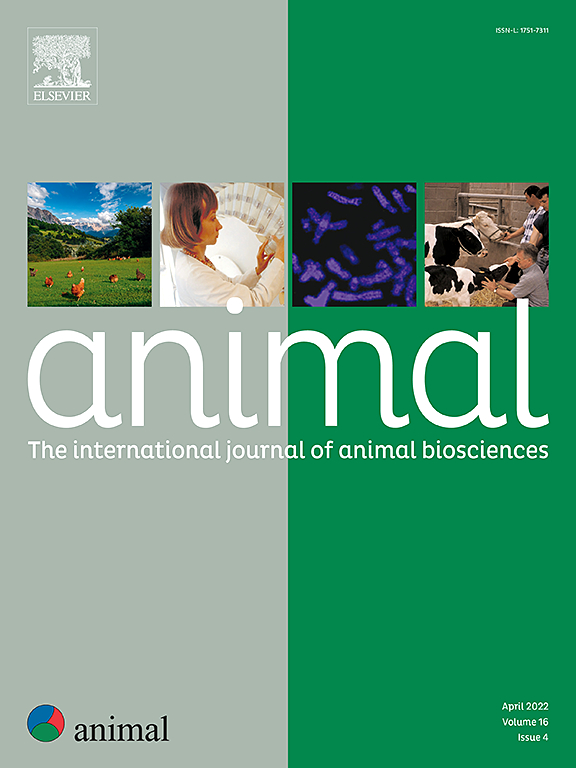Review: Antimicrobial resistance of Klebsiella pneumoniae isolated from poultry, cattle and pigs
IF 4
2区 农林科学
Q1 AGRICULTURE, DAIRY & ANIMAL SCIENCE
引用次数: 0
Abstract
Klebsiella pneumoniae, common pathogenic bacteria, cause dangerous infectious diseases in animals and humans. Klebsiella pneumoniae have numerous resistance mechanisms to antibacterials and the frequency of resistant K. pneumoniae isolates increases, making treatment of K. pneumoniae-induced infections difficult. Farm animals are a possible source of antibacterial resistant K. pneumoniae. The aim of this literature review (2018–2024) was to evaluate the antibacterial resistance of K. pneumoniae isolated from poultry, cattle and pigs in various countries. The analysis shows that farm animals are an important source of antibacterial-resistant and multidrug-resistant K. pneumoniae and that resistance patterns differ among antibacterial groups, animals and locations. In poultry, high resistance to penicillins (91%), III and IV generation cephalosporins (> 50%) occurred, and low to carbapenems (5%) and polymyxins (6%). In cattle, high resistance to sulphonamides (76%), IV generation cephalosporins, macrolides and lincosamides, and penicillins occurred (> 50%), and low to carbapenems (10%) and polymyxins (1%). Isolates from pigs showed high resistance to I and II-generation cephalosporins, I-generation fluoroquinolones, macrolides and lincosamides, tetracyclines (> 50%) and carbapenems (> 20%), and low to polymyxins (5%). The highest resistance rates to most antibacterial groups occurred in pigs, and in Africa and Asia, while the lowest in cattle, and in North and South America. Particularly, the relatively high resistance of K. pneumoniae to carbapenems and polymyxins in Africa poses a threat to animal and human health as these antibiotics are the last resort therapeutics used to treat severe infections. Different rates of K. pneumoniae resistance to antibacterials among isolates from farm animals probably result from differences in the treatment of each animal group with various antibacterial agents and different regimes of their use in various locations.
回顾:从家禽、牛和猪中分离的肺炎克雷伯氏菌的抗菌药耐药性
肺炎克雷伯氏菌是一种常见的致病菌,可导致危险的人畜传染病。肺炎克雷伯氏菌对抗菌药有多种耐药机制,耐药肺炎克雷伯氏菌分离株的出现频率增加,导致肺炎克雷伯氏菌引起的感染难以治疗。农场动物是耐抗菌肺炎克氏菌的可能来源。本文献综述(2018-2024 年)旨在评估各国从家禽、牛和猪中分离出的肺炎克氏菌的抗菌耐药性。分析表明,农场动物是耐抗菌和耐多药肺炎克氏菌的重要来源,不同抗菌组、不同动物和不同地区的耐药模式各不相同。在家禽中,对青霉素类(91%)、第三代和第四代头孢菌素类(50%)的耐药性较高,而对碳青霉烯类(5%)和多粘菌素类(6%)的耐药性较低。在牛中,对磺胺类药物(76%)、第四代头孢菌素、大环内酯类、林可霉素类和青霉素类的耐药性较高(50%),对碳青霉烯类(10%)和多粘菌素类(1%)的耐药性较低。猪的分离菌株对第一代和第二代头孢菌素、第一代氟喹诺酮类、大环内酯类和林可酰胺类、四环素类(50%)和碳青霉烯类(20%)的耐药性较高,而对多粘菌素类(5%)的耐药性较低。猪、非洲和亚洲对大多数抗菌药类的耐药率最高,而牛、北美和南美的耐药率最低。特别是在非洲,肺炎克氏菌对碳青霉烯类和多粘菌素的耐药性相对较高,这对动物和人类健康构成了威胁,因为这些抗生素是治疗严重感染的最后手段。农场动物分离物中的肺炎克氏菌对抗菌药的耐药率不同,可能是由于各地对不同动物群体使用不同抗菌药和不同抗菌药使用方案造成的。
本文章由计算机程序翻译,如有差异,请以英文原文为准。
求助全文
约1分钟内获得全文
求助全文
来源期刊

Animal
农林科学-奶制品与动物科学
CiteScore
7.50
自引率
2.80%
发文量
246
审稿时长
3 months
期刊介绍:
Editorial board
animal attracts the best research in animal biology and animal systems from across the spectrum of the agricultural, biomedical, and environmental sciences. It is the central element in an exciting collaboration between the British Society of Animal Science (BSAS), Institut National de la Recherche Agronomique (INRA) and the European Federation of Animal Science (EAAP) and represents a merging of three scientific journals: Animal Science; Animal Research; Reproduction, Nutrition, Development. animal publishes original cutting-edge research, ''hot'' topics and horizon-scanning reviews on animal-related aspects of the life sciences at the molecular, cellular, organ, whole animal and production system levels. The main subject areas include: breeding and genetics; nutrition; physiology and functional biology of systems; behaviour, health and welfare; farming systems, environmental impact and climate change; product quality, human health and well-being. Animal models and papers dealing with the integration of research between these topics and their impact on the environment and people are particularly welcome.
 求助内容:
求助内容: 应助结果提醒方式:
应助结果提醒方式:


